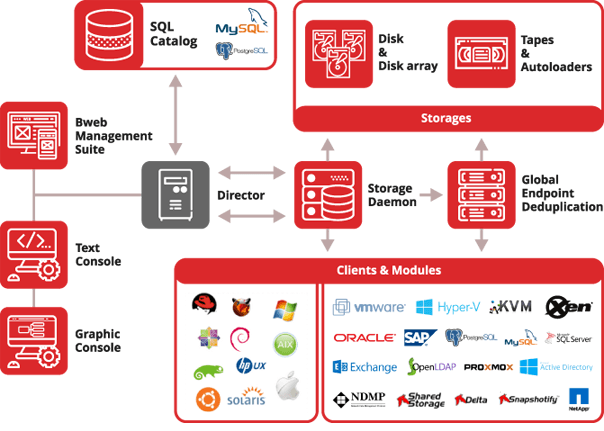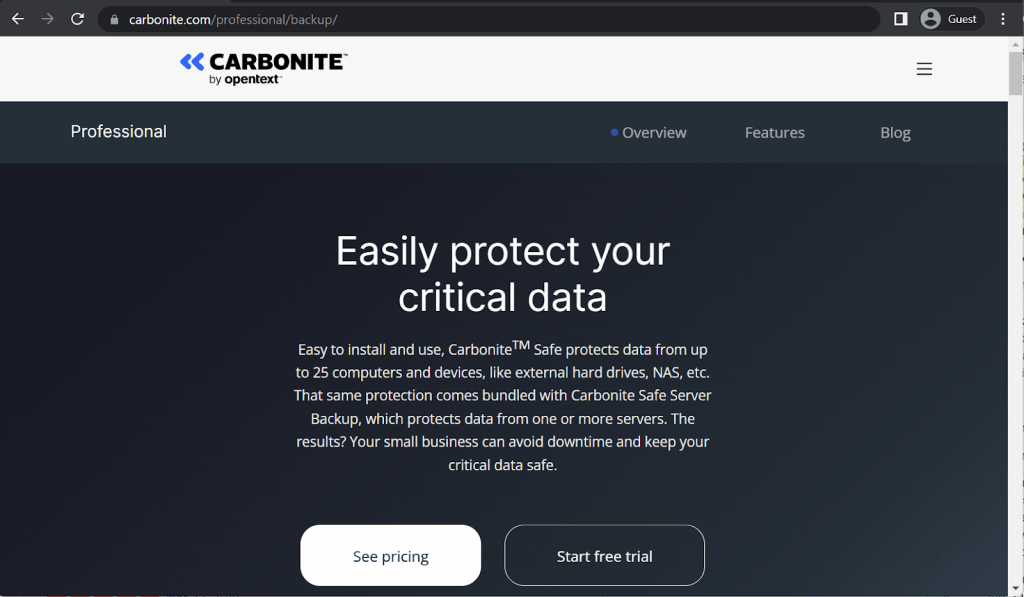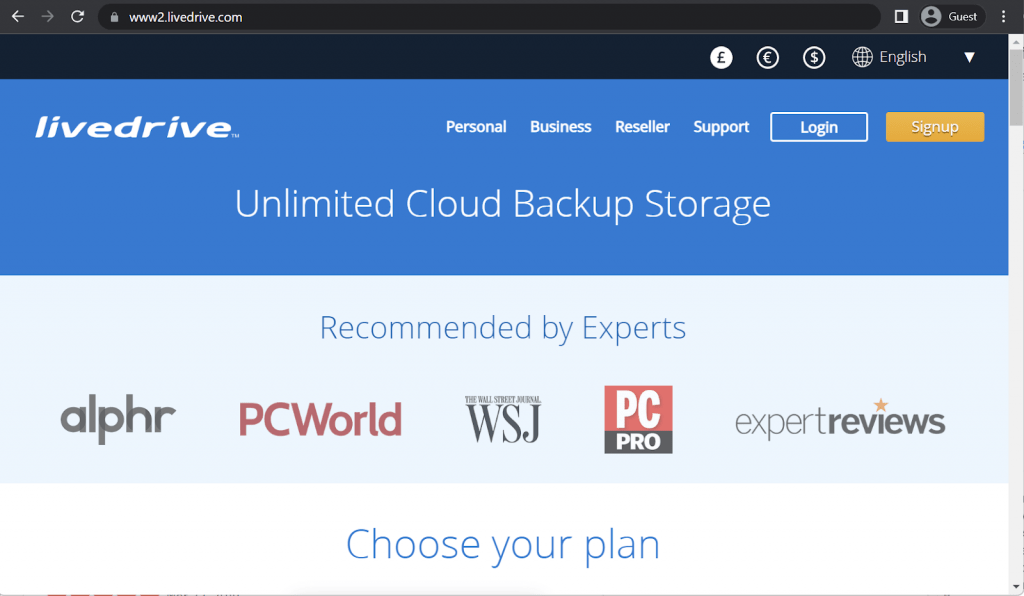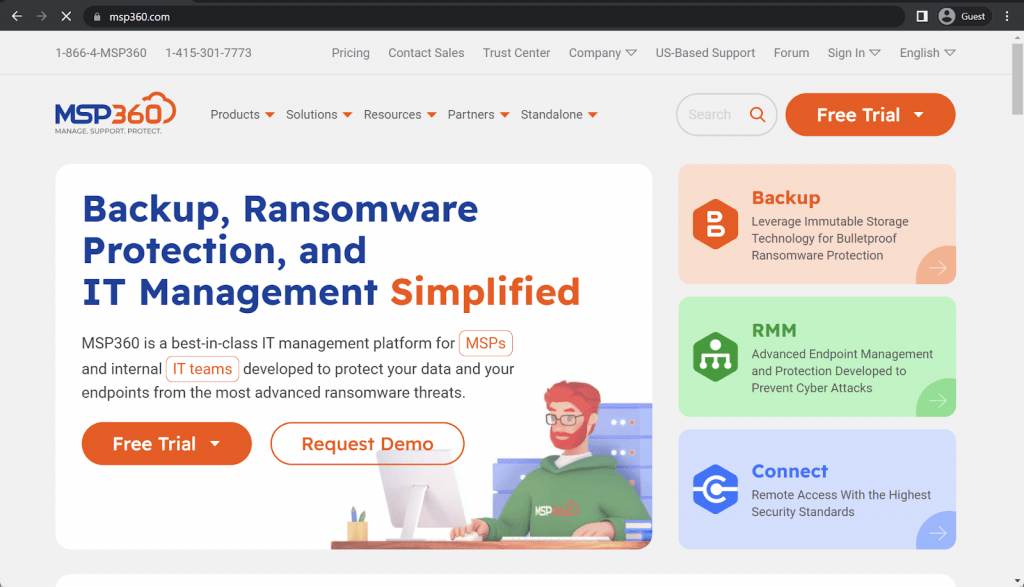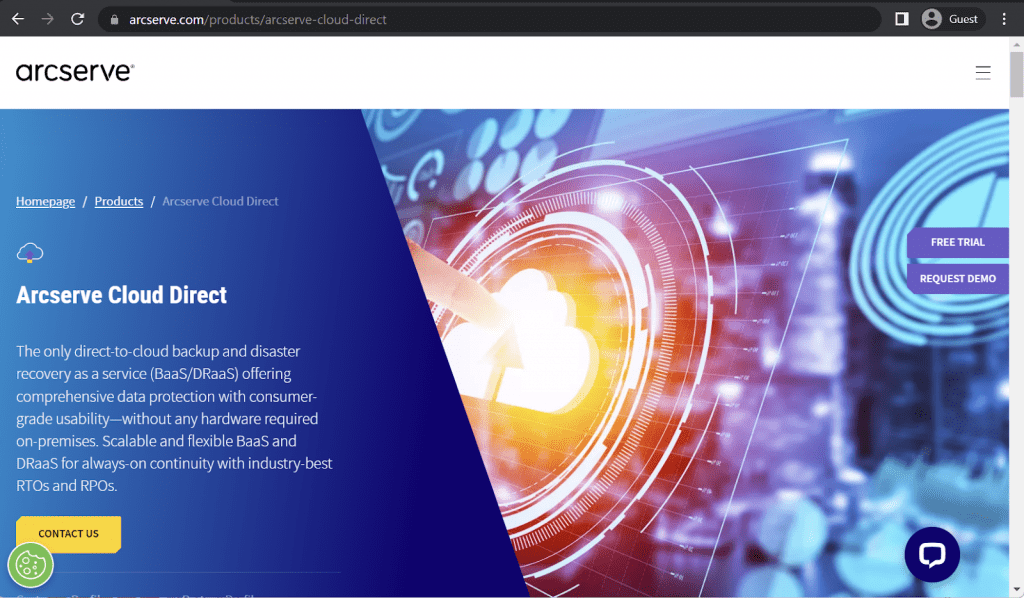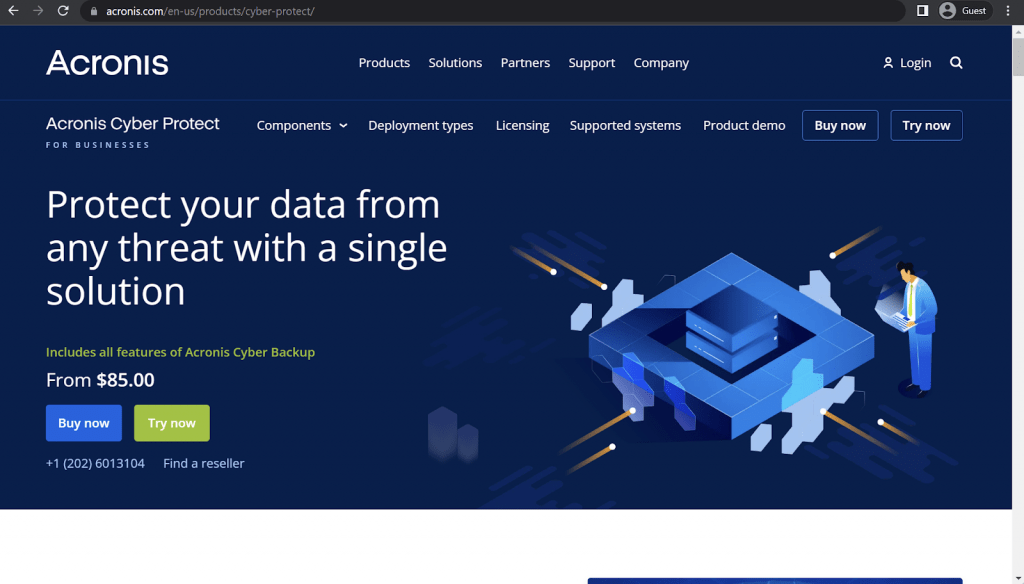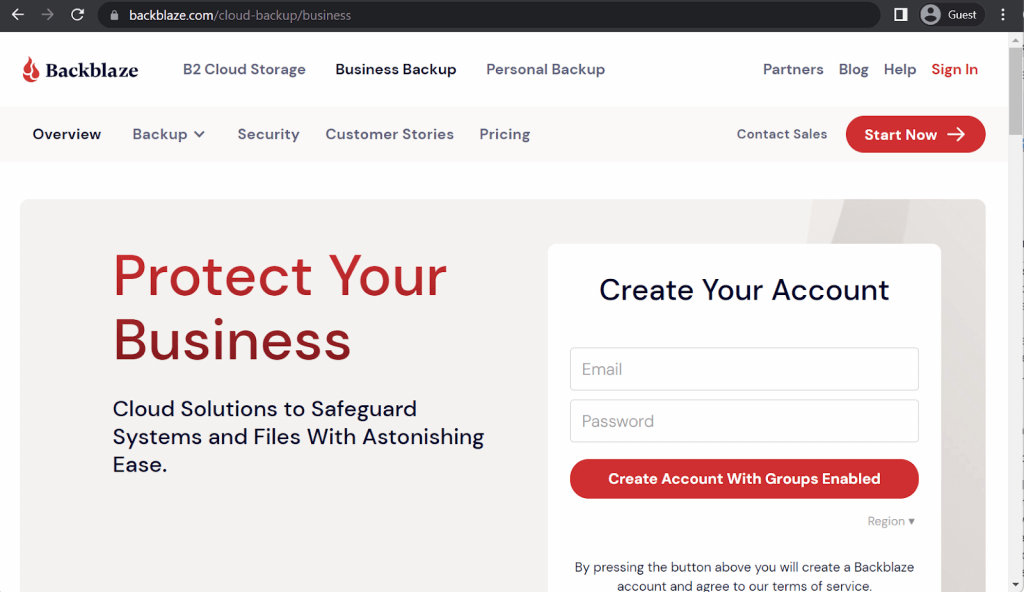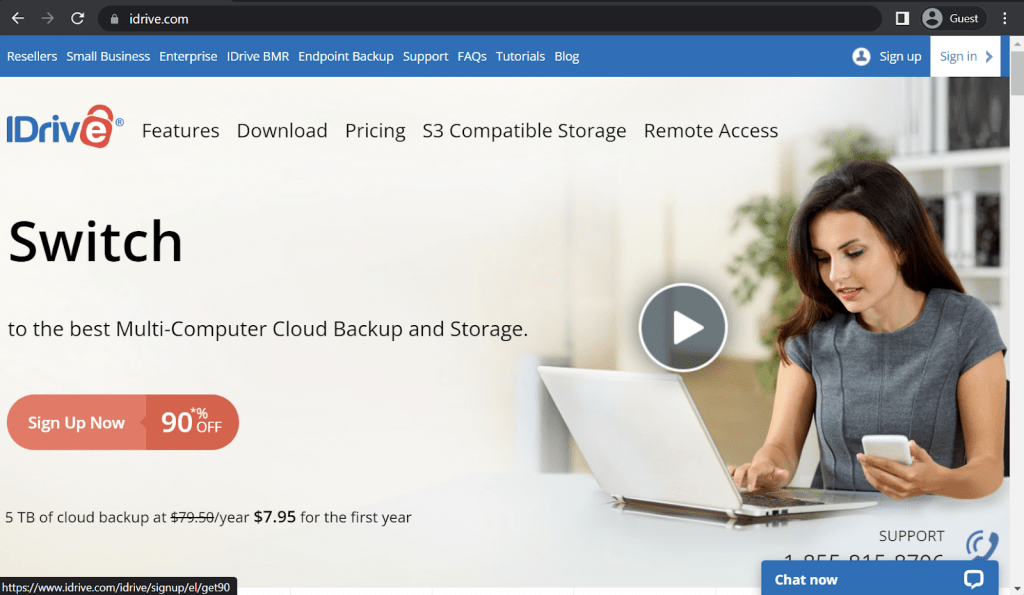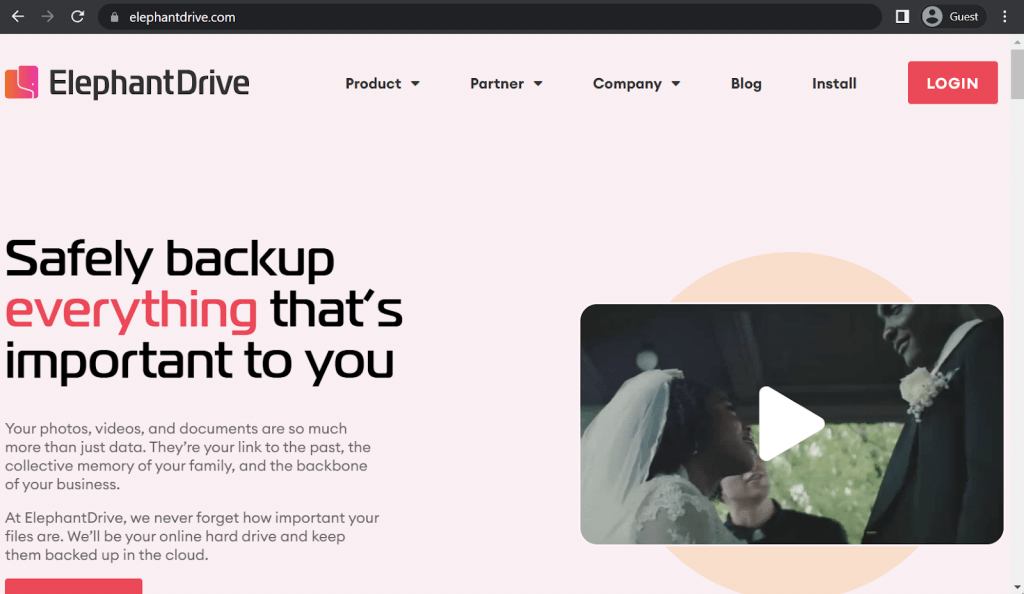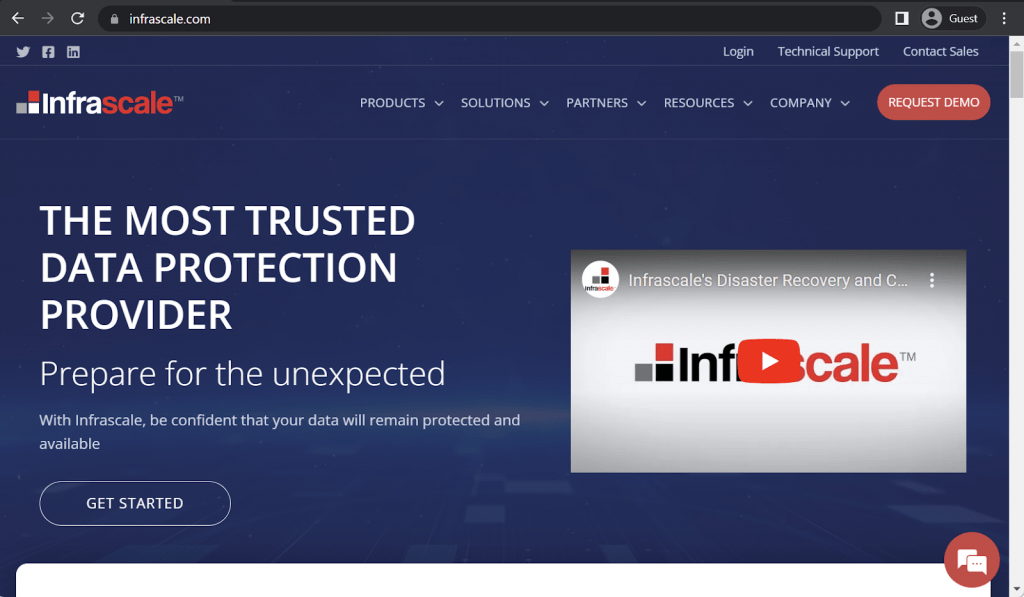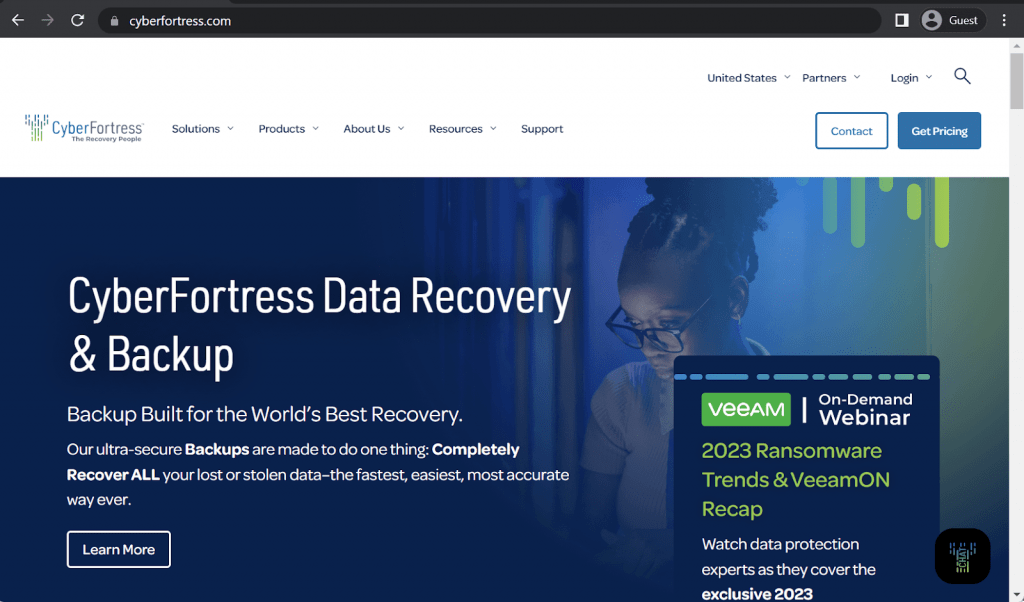Examples of offsite backup solutions
Since the number of features and details to look out for is very broad, it may be better for us to try and change the approach a little. Instead of going for more “things to look out for” and “best practices”, we are going to try and present a list of examples of software that can be considered an offsite backup solution. This particular list is not a rating or a comparison, every solution is looked at with as much objectivity as possible.

Carbonite Safe is a software lineup from Carbonite that was created specifically for professional use, it packs a respectable range of capabilities, including backup, recovery, granular restore, data protection capabilities, and support for all types of deployments (physical, virtual, cloud, even hybrid). It can create snapshots, perform full, incremental, or differential backups, and more.
Carbonite itself is a rather notable name in the business cloud backup industry, and the Safe product lineup can cover regular desktops, laptops, and even servers – with features such as ransomware recovery, and 128-bit encryption, to name a few. Carbonite’s protection measures are also compliant with HIPAA, GLBA, and FERPA, making it a great option for smaller teams (strictly up to 25 people) that have to be compliant to a specific standard or standards.
Customer ratings:
- Capterra – 4.3/5 stars based on 165 customer reviews
- TrustRadius – 10/10 stars based on 29 customer reviews
- G2 – 4.0/5 stars based on 195 customer reviews
Advantages:
- Carbonite’s customer support receives nothing but praise from the overwhelming majority of the customers, and the fact that it is available 24/7 makes the customer experience even better
- General ease of use is a massive benefit to Carbonite, especially in the market full of complex backup solutions with an outdated interface
- Despite its apparent simplicity, Carbonite can still work with plenty of different storage types, from endpoints and servers to external drives, and more
Shortcomings:
- A hard limitation of 25 computers would be an inconvenience for many businesses, which is why Carbonite Safe is only suitable for some SMBs and practically unsuitable for large enterprises
- Carbonite Safe has its own limitations on the technological site, as well, with the solution not supporting smartphones or other mobile devices at all, as well as the entire solution not working with third-party cloud storage services at all
- Carbonite’s Mac version seems to have plenty of issues that are absent from the Windows version, including plenty of errors, infrequent backup speed slowdowns, as well as the software taking over the entire system’s resources, leading to lags and generally uncomfortable experience
Pricing:
- Carbonite Safe is one of several branches of Carbonite’s software offerings, and this particular branch has three different pricing options:
- “Carbonite Safe – Core” – $24 per month, a basic feature offering from Carbonite that can cover up to 25 computers without a server, and includes 250GB of secure and encrypted cloud storage
- “Carbonite Safe Server Backup – Power” – $50 per month, offers one server and up to 25 computers, as well as 500GB of secure and encrypted cloud storage
- “Carbonite Safe Server Backup – Ultimate” – $83.33 per month, does not have any limitations for the number of servers covered (still limited to 25 computers at once), and the same offering of 500GB of cloud storage as the previous pricing plan
- It is worth noting that both “Power” and “Ultimate” pricing plans are sold at a discount right now, meaning that the price may differ in the future
My personal opinion on Carbonite:
Carbonite established its reputation in the business cloud backup field quite a while ago, with its variety of features and supported deployment types. It is not particularly expensive and offers quite a few unusual features, including its compliance to HIPAA and several other standards. Its Mac version has a few issues here and there, and the lack of mobile device support is a significant disadvantage, but the biggest issue for Carbonite’s popularity is the hard limitation on just 25 computers per single license, which makes it rather unappealing for larger businesses.

Livedrive is a rather unusual pick for this particular list, since this cloud storage solution is not suitable for clients outside of the EU or UK at all. Livedrive’s servers are located in Europe and the service itself is focused on working with European businesses first and foremost. At this point, Livedrive supports the Netherlands, Italy, Spain, Germany, and France (with a promise to expand to other countries in the future).
One of the biggest advantages of Livedrive is its compliance with the General Data Protection Regulation (GDPR), which is extremely important for companies that are physically located in the EU or UK in the first place. It can technically work for customers from other companies, but most of the other large regions of the world (such as the US) have plenty of solutions with more affordable pricing available already.
Customer ratings:
- Capterra – 3.4/5 stars based on 10 customer reviews
- G2 – 3.6/5 stars based on 7 customer reviews
Advantages:
- GDPR compliance for EU/UK-based companies is a massive advantage in and of itself, since becoming compliant to this particular standard is no small feat
- Livedrive can offer the basic set of security features to its clients – end-to-end data encryption and two-factor authentication, to be more specific
- The solution allows for more storage and/or more users to be added with minimal effort
Shortcomings:
- Livedrive’s pricing is not particularly user-friendly, even for some companies that are located in the EU or UK, since the solution’s total cost tends to scale up extremely fast as soon as extra storage is needed
- As surprising as it may be, Livedrive is not HIPAA-compliant, which can be a big turning point for some potential clients
- Livedrive also offers little to no features when it comes to data protection (aside from 2FA and data encryption) – which means no ransomware protection, no scanning for malware, etc.
Pricing:
- Livedrive’s pricing model is fairly simple in itself, with only three different pricing plans to choose from:
- “Backup” – £6.99 per month, a basic package intended for a single user, does not have any limitations on the amount of cloud storage available
- “Briefcase” – £10.99 per month, another interesting offering from Livedrive, offers 2TB of Briefcase storage to its users, as well as the ability to back up both desktop and mobile devices
- “Pro Suite” – £15.99 per month, the biggest starting offering from Livedrive that includes both “Backup” and “Briefcase” plans, can offer 5TB of Briefcase storage, backups for mobile devices and tablets, as well as 5 user account backups for either Mac or Windows users
- It is worth noting that this information only covers the baseline pricing of Livedrive, and adding more users or more storage is bound to have an additional cost attached to it
My personal opinion on Livedrive:
Livedrive would’ve been a rather basic cloud storage solution with a higher-than-average pricing if it wasn’t for the fact that it is region-locked. There is a very short list of countries that Livedrive currently works in to its fullest, and trying to purchase it from another location is far too expensive to try it in the first place. The fact that Livedrive is GDPR-compliant, on the other hand, is a massive advantage to practically any EU-based company since all of them have to be compliant to GDPR in the first place.
MSP360 (formerly Cloudberry Lab)

MSP360 has been known as Cloudberry Labs for quite a while, and its rebranding is fairly recent – it managed to keep all of the previously existing features while also adding new ones to the package. As a cross-platform backup and recovery solution with plenty of integrations and features to choose from, MSP360 successfully builds up from its predecessor’s legacy, offering features such as data compression, data encryption, file-level backups, image-based backups, and many others.
What is interesting to know about MSP360 is that the solution itself is mostly aimed at managed service providers (MSP) that resell the service in question – even though it can still be purchased and configured directly. MSP360 offers the ability to choose from a number of third-party cloud services as your cloud storage, including AWS, Backblaze, and many others – and combine that storage with any local storage the client may have already for a seamless experience.
Customer ratings:
- Capterra – 4.7/5 stars based on 204 customer reviews
- TrustRadius – 8.1/10 stars based on 45 customer reviews
- G2 – 4.5/5 stars based on 403 customer reviews
Advantages:
- MSP360 is a good example of a comprehensive backup solution with a relatively simple initial setup/configuration process
- As a rather complex data protection solution, MSP360 is capable of working as a centralized data management software, offering a quick overview of different data sources and storage types within the same company
- A lot of MSP360’s basic features, such as data recovery or data backup, are easy to work with and simple in terms of configuration
Shortcomings:
- MSP360 may claim that they are suitable for businesses of any size, there’s little to no SMB customers for this particular solution simply because it is a lot more expensive than these businesses can afford
- MSP360 does have a customer support team, and user reviews about the effectiveness of customer support vary quite a lot, ranging from completely useless to extremely useful and everything in-between
- Despite the fact that MSP360 does not reveal any kind of public pricing at their official website, there are plenty of customer reviews citing that a lot of the features are not included in the “base” package and have to be acquired separately for an additional price
Pricing:
- MSP360’s pricing information is not publicly available on their official website and the only way to obtain such information is by contacting the company directly for a quote.
- Their special “quote calculator” page allows potential customers to specify what device types they want to be backed up in the future. This particular page allows for three different solution types to be mentioned.
- The first one is MSP360 Managed Backup – a cross-platform backup and recovery solution, this part allows a potential customer to specify how many devices and data sources of specific types they need covered by the solution, including:
- Windows Desktop
- Windows Server
- MS Exchange
- MS SQL Server
- Mac OS Desktop
- Linux Desktop
- Hyper V Server or Server Socket
- VMware Server or Server Socket
- Microsoft SharePoint
- Microsoft Teams
- Microsoft 365
- Google Shared Drives
- Google Workspace
- The second one is MSP360 RMM – a trustworthy endpoint management solution with options such as RMM (priced per administrator), and deep instinct (priced per endpoint)
- The last option is MSP360 Connect – a well-protected remote access solution, it allows for the number of potential remote access devices on either Windows or Mac platform to be specified
- Additionally, a potential customer has the option to mention the need for premium support, onboarding, custom SSL, and advanced rebranding
- After the correct number of options for each data source have been selected, a potential client has to provide additional information about the company in question so that they can be contacted later with a personalized quote.
My personal opinion on MSP360:
MSP360 is an example of a more traditional comprehensive backup solution that also offers the ability to store backups in the cloud. Building upon the legacy of Cloudberry Labs, MSP360 offers cross-platform backup and recovery software with an impressive list of features to work with, and also a number of different cloud storage providers to choose from (AWS, Backblaze, etc.). There are three main products that MSP360 can offer, and each of them covers its own specific niche, be it general backup and recovery tasks, endpoint management, or even remote access.

Arcserve as a software provider is quite an interesting company with a variety of different solutions, and their cloud-oriented Arcserve Cloud Direct is also quite interesting in itself. It is a rather sophisticated offsite backup solution that offers a variety of very specific high-end features that you would usually only see in an IT-grade environment, it can perform backups and restores in highly distributed environments, replicate virtual infrastructures, perform disaster recovery operations, and so much more.
However, the complexity of this solution is a double-edged sword of sorts, with the feature set itself being a hard sell for most SMBs with the lack of any kind of public pricing available whatsoever. The same could be said for larger businesses, as well, but if the price is not the main argument for the company, and especially if the company itself has a dedicated IT personnel, then Arcserve Cloud Direct may be one of the best offsite backup solutions a business can ask for.
Customer ratings:
- G2 – 4.3/5 stars based on 15 customer reviews
Advantages:
- As a cloud solution, Arcserve Cloud Direct does not have to be physically attached to a company’s server using some form of hardware appliance, it can provide cloud-native backup and recovery options after virtual deployment
- Arcserve has plenty of different software and solutions to choose from, and Cloud Direct specifically boasts a surprisingly long list of IT-grade features when it comes to its data protection capabilities – including disaster recovery, backup operations, restore tasks, and more
- Despite the fact that Arcserve’s cloud solution boasts a large variety of complex features and capabilities, most of these features are surprisingly easy to work with and should be easy to work with for practically any IT specialist out there
Shortcomings:
- Arcserve’s lack of support for any kind of mobile device may be a dealbreaker for some potential customers, purely because of how many mobile devices are used inside of a single company on a regular basis
- There is no public information about the pricing of Arcserve’s cloud solution, but the variety of different expert-level features make sure that this particular offering would not be suitable for smaller businesses whatsoever, and the lack of any kind of approximate pricing may even turn some of the bigger clients away
- Arcserve Cloud Direct may be a cloud-centric solution, but the fact that it does not have any form of data deduplication to reduce storage requirements is not a good look from the competitive standpoint
- Some of Arcserve’s tools and offerings are not as tightly integrated as they perhaps should be, causing potential pain to the user.
Pricing:
- Arcserve does not usually reveal any kind of pricing information about its solutions publicly. As such, the only way to receive such information for a company is for that company to request a personalized quote.
My personal opinion on Arcserve:
Arcserve as a software provider is not exactly the most popular company on this market, but it would not be true to call it completely unknown, either. Arcserve offers a variety of different solutions and software to choose from, one of which being their Cloud Direct solution – a comprehensive cloud-oriented offsite backup platform with a lot of features that are usually only present in very complex enterprise-level backup software. Unfortunately, this kind of complexity is also one of the biggest detriments of Arcserve’s popularity, leading to both small and large companies not picking it for one reason or another – but it still has its audience, and remains a great option for middle-sized teams with IT departments that know what they’re doing.

Acronis is quite a well-known backup solution provider, offering a small selection of solutions for different use cases. Acronis Cyber Protect is considered the flagship solution of the company, offering a comprehensive approach to data security that also covers offsite backup capabilities. It focuses on cybersecurity, integrated protection management, and backup/recovery tasks at the same time, offering an incredibly versatile data security platform with a wealth of capabilities.
Acronis Cyber Protect is a very effective solution, but it is not the cheapest one, and also not the easiest one to work with. Drawbacks like these are what keeps Acronis from dominating the entire market – and it still manages to earn quite the reputation for itself over the years as one of the best backup solutions with cybersecurity capabilities.
Customer ratings:
- Capterra – 4.5/5 stars based on 204 customer reviews
- TrustRadius – 7.8/10 stars based on 133 customer reviews
- G2 – 4.3/5 stars based on 668 customer reviews
Advantages:
- Data collection is extremely easy with Acronis and can be performed any any point in time with little to no effort from the user
- Acronis Cyber Protect may be a security-focused solution, but it is also a great backup solution that supports workstations, VMs, applications, servers, and many other deployment types
- AI-based malware detection and comprehensive monitoring are just some of the security-related features that Acronis can offer to its customers
Shortcomings:
- A lot of customers consider the UI of Acronis Cyber Protect to be rather outdated and not particularly straightforward in its logic
- The backup agent of Acronis has quite the appetite – its hardware requirements are surprisingly high, even by this market’s standards
- The same could be said for how Acronis approaches pricing, there may be several different pricing models and solution types, but the average pricing of Acronis is often deemed well above market average, making it unattainable for some SMBs. Conversely, Acronis may not be a good technical fit for large enterprises.
- Limited technical scalability; Acronis may not work well for large enterprises.
- No Kubernetes support
Pricing:
- There are three versions of Acronis Cyber Protect that differ quite a lot in their approach to pricing – Standard, Advanced, and Backup Advanced (Acronis Cyber Protect – Backup Advanced is an extension of a legacy software called Acronis Cyber Backup, the standard package of this software’s capabilities is now included in Acronis Cyber Protect Standard by default)
- Acronis Cyber Protect Standard and Advanced have their own share of differences, with the Advanced version building upon the Standard version by adding SAN storage snapshots, Acronis ASign, Acronis Notary, tape backup support, Xenserver support, Oracle VM Server support, and more.
- As such, it is fairly normal for the Advanced version to cost more than the Standard one, including:
- From $85/$129 (Standard/Advanced respectively) per one workstation, be it physical or virtual, macOS or Windows
- From $595/$925 (Standard/Advanced respectively) for one server, be it physical or virtual, Linux or Windows
- From $705/$1,175 (Standard/Advanced respectively) per one virtual host, be it Hyper-V or VMware (no limitations on the number of virtual machines per host)
- From $285 for one instance of Microsoft Windows Server Essentials (physical/virtual), includes application backup, only available in Acronis Cyber Protect Standard
- The capabilities of Acronis Cyber Protect – Backup Advanced have a completely different approach to pricing depending on the nature of the backup target:
- From $109 per one workstation, be it physical or virtual, macOS or Windows
- From $779 for one server, be it physical or virtual, Linux or Windows
- From $1,019 per one virtual host, be it Hyper-V or VMware (no limitations on the number of virtual machines per host)
- From $139 for either Microsoft 365 data (across SharePoint Online, Teams, OneDrive for Business or Exchange Online) or Google Workspace data (across Contacts, Calendar, Drive, or Gmail)
- Acronis Cyber Protect – Backup Advanced can offer file-level backups, image-based backups, incremental/differential backups, ransomware protection, vulnerability assessment, group management, AD integration, reports, and more.
My personal opinion on Acronis:
Acronis is one of the most well-known backup software providers on the market, and it is widely known that Acronis puts a lot of emphasis on security features in its applications – comprehensive data monitoring, AI-assisted malware detection, and plenty of other features as well. That’s not to say that there are no backup options to choose from – since Acronis Cyber Protect also supports a variety of backup-related storage target locations, such as servers, workstations, applications, and many others. Possibly not the best choice for a large enterprise’s backup and recovery.

Backblaze as a company is mostly known for its B2 Cloud storage offering – an infrastructure-as-a-service product that plenty of backup vendors can work with. However, that is not the only product or service that Backblaze offers. Backblaze Business Backup is a good example of that – a primarily cloud solution that was created in order to safeguard files and systems, be it workstations/endpoints, servers, NAS, or even the data of Veeam customers.
Backblaze Business Backup has plenty of backup options to choose from, be it downloading from the cloud, copying from the cloud to some other storage unit, or even using the company’s own external hard drive to copy your data – a hard drive that the company would send to you afterwards. The aforementioned feature is practically free if the storage unit is returned afterwards, and if it isn’t – the price is not that high, either.
Customer ratings:
- TrustRadius – 9.0/10 stars based on 60 customer reviews
Advantages:
- One of the biggest advantages of Backblaze Business Backup is the fact that no user is limited by the amount of storage space they work with
- The aforementioned unusual hard-drive-by-mail feature is not the most convenient option in the world, but at least it stands out, which is also an advantage for the solution as a whole
- The solution itself does not consume a lot of resources while running in the background, and it can be integrated with Backblaze B2 with little effort, since both come from the same company in the first place
Shortcomings:
- Backblaze Business Backup does not have any Linux client at all, which limits its reach in terms of potential client base – not to mention security questions
- Business Backup may be a solution that can perform backup and recovery tasks, but it lacks quite a lot of features that most competitors have, such as the ability to gather and show advanced backup analytics to its users whenever necessary
- Limited scalability flexibility and technology compatibility.
Pricing:
- Backblaze Business Backup has a rather simple pricing model that is split in four “categories”:
- Creating a server backup costs $5 per Terabyte per month, copying a customer’s data to B2 Cloud Storage
- Creating a NAS backup also costs $5 per Terabyte per month, with the ability to work with TrueNAS, QNAP, and Synology
- Creating a workstation backup is priced at $70 per year per workstation, and there is always an option to change the billing to monthly or bi-yearly if the client chooses to do so
- Creating a backup of Veeam data is also priced at $5 per Terabyte per month, an integration that no other solutions have in the first place
My personal opinion on Backblaze:
Backblaze is not just about its cloud storage in the form of B2 Cloud – it is also quite a comprehensive cloud data solution with plenty of features to work with. One of the less common features here is to write a backup copy or several to a single hard drive and then to physically send to it the recipient. This feature itself is fairly cheap, and the same could be said for the entirety of the solution, as well – even though there are plenty of offerings on the market that offer the same feature set for a higher price.

iDrive does not have enough features to stand at the same level as comprehensive enterprise-level backup solutions, and it is not really trying to do so. There are several different pricing tiers that iDrive offers, one of which is called iDrive Team – a rather inexpensive set of features that allows five (or more) users to be connected to one account with 5 Terabytes worth of cloud backup (or more). It is a great option for smaller businesses that can manage their entire team’s data from a single centralized interface with a solution that can also cover mobile devices and NAS, not just desktops.
iDrive as a solution may not be the best option for hundreds of people at once – but not every company in the world is a massive enterprise with thousands of people working there. iDrive also has other tiers for larger businesses, such as Enterprise or Business, but iDrive Team is at its best when working for smaller companies that value versatility and high price-to-performance ratio.
Customer ratings:
- Capterra – 4.6/5 stars based on 739 customer reviews
- TrustRadius – 7.2/10 stars based on 29 customer reviews
- G2 – 4.4/5 stars based on 1,163 customer reviews
Advantages:
- iDrive’s capability to work with regular workstations, NAS, and mobile devices is a massive advantage and is practically unheard of in this price range
- Similar to Backblaze, iDrive can send backups in physical storage units transported by regular mail
- Another massive advantage of iDrive is its extremely low pricing, something that a lot of SMBs are very grateful for
Shortcomings:
- iDrive’s malware and ransomware protection capabilities are very limited and practically nonexistent
- iDrive’s web-based user interface is not exactly polished and is not as user-friendly as it could be
- Setting up iDrive for Linux devices is far more complicated than with Windows-based workstations
- iDrive is often limited to suitability for only small businesses
Pricing:
- iDrive is quite a versatile solution, there are different pricing plans with different feature sets, but the solution itself is still the same, which is why the pricing can be a bit confusing
- iDrive Team is the centerpiece of this segment of the article, and iDrive offers quite a lot of pricing plans depending on the number of computers/users that the client needs to cover:
- $9.95 per month for 5 computers, 5 users, and 5 Terabytes of storage
- $19.95 per month for 10 computers, 10 users, and 10 Terabytes of storage
- $49.95 per month for 25 computers, 25 users, and 25 Terabytes of storage
- $59.95 per month for 30 computers, 30 users, and 30 Terabytes of storage
- $69.95 per month for 35 computers, 35 users, and 35 Terabytes of storage
- $79.95 per month for 40 computers, 40 users, and 40 Terabytes of storage
- $89.95 per month for 45 computers, 45 users, and 45 Terabytes of storage
- $99.95 per month for 50 computers, 50 users, and 50 Terabytes of storage
- $199.95 per month for 100 computers, 100 users, and 100 Terabytes of storage
- $399.95 per month for 200 computers, 200 users, and 200 Terabytes of storage
- $599.95 per month for 300 computers, 300 users, and 300 Terabytes of storage
- $799.95 per month for 400 computers, 400 users, and 400 Terabytes of storage
- $999.95 per month for 500 computers, 500 users, and 500 Terabytes of storage
- All of these plans can be purchased for 1 or 2 years in advance, providing a discount to the total price
My personal opinion on iDrive:
iDrive is one of the least expensive cloud backup solutions on this list, with an impressive feature range and several types of data it can work with. It is an affordable offsite backup option mostly suitable for smaller companies that struggle to afford an offsite backup solution in the first place. It has its own flaws, such as the lack of any serious malware protection in place, or the complexity of the Linux software version, but the general consensus is that iDrive Team is an interesting solution for small businesses with low expectations from cloud backup software.

Backups and cloud synchronization are the focus of ElephantDrive – a set of versatile data protection tools that are also easy to work with. ElephantDrive claims to offer a level of data security and data management that was previously only available to large companies and enterprises. ElephantDrive’s data is always AES-256 encrypted at rest and transferred using 128-bit SSL secured channel, and it can also integrate with NAS devices of all major hardware providers to offer direct backups from NAS, as well as traditional endpoint backups.
Customer ratings:
- Capterra – 4.7/5 stars based on 14 customer reviews
- G2 – 4.2/5 stars based on 12 customer reviews
Advantages:
- Automatic backups add a lot of convenience to the solution
- The convenience of all data being encrypted both in transit and at rest
- ElephantDrive as a cloud backup solution is relatively cheap by this market’s standards
Shortcomings:
- The structure of the solution is fairly rigid and sharing files is rather difficult
- The interface is not particularly user-friendly
- There’s no first-time tutorial or guide after initial setup
- This seems like another solution that is only likely to be of use for small organizations
Pricing:
- ElephantDrive’s pricing is as simple as it gets, with only two pricing plans
- $10 per month for 1TB of storage, 10 devices, 3 sub-accounts, and the max file size of 10GB
- $20 per month for 2TB of storage, 25 devices, 10 sub-accounts, up to 50GB of max file size and premium customer support
My personal opinion on ElephantDrive:
ElephantDrive is a small-scale backup and recovery solution – it may offer quite an impressive security to customer backups, such as the AES-256 encryption at rest and 128-bit SSL protection in transit. It is also one of the cheapest solutions on the list, and its automation capabilities are impressive, but it may be difficult to set up initially, with the overall interface not being particularly user-friendly. Additionally, the solution’s structure is rather rigid and sharing data with other users may prove to be difficult.

Infrascale is another example of a solution attempting to provide enterprise-grade disaster recovery without the complexity and the price that usually comes with such a solution. Infrascale can be delivered as either a virtual or a physical appliance, it includes disaster recovery capabilities, and supports plenty of backup storage locations, with the biggest one being the cloud. Infrascale managed to develop its own set of tools that is easy to manage and can offer a reliable and affordable alternative to a complete enterprise-level backup and recovery system.
Customer ratings:
- TrustRadius – 9.6/10 stars based on 10 customer reviews
- G2 – 4.3/5 stars based on 10 customer reviews
Advantages:
- A solution that is fast, versatile, and feature-rich
- Storage space usage is as efficient as it gets, combining encryption and deduplication for maximum effectiveness
- Supports server backup, application backup, and other target backup types
Shortcomings:
- May not be particularly user-friendly when it comes to specific features
- More complex backup operations require a lot of knowledge in the field to configure everything correctly
- There is no changed block tracking technology and the solution must scan the entire file storage in order to be able to track changes in the first place
Pricing:
- There is no public pricing data available at Infrascale’s website, the only official way to obtain any kind of pricing information is to request a personalized quote
My personal opinion on Infrascale:
Infrascale is a small solution that tries to provide enterprise-grade disaster recovery capabilities to its users while also not being too complex for its own good. It can offer efficient storage usage (deduplication + encryption), multiple different backup target types, and a generally high performance across the board. It is not very user-friendly, and some less basic tasks may be difficult to set up without a proper technical background, but it is still a notable effort to create a great backup solution for smaller businesses.

CyberFortress helps businesses to stay safe from both accidents and intentional cyberattacks, securely backing up important data as a whole and all of the employee data, as well. CyberFortress is a software provider that offers a variety of services and solutions that cover different parts of essential data security, ranging from firewalls and malware defense to content filtering, online cloud backup, and more. It also has encryption, network protection, substantial storage type variety, and more.
Customer ratings:
- G2 – 4.1/5 stars based on 31 customer reviews
Advantages:
- It is true that there is no public pricing available from CyberFortress, but many users have reported it as a great price-to-value offering
- Outstanding customer support is always ready to help with any kind of software-related problem or issue
- Very simple user interface as a whole, without any kind of steep learning curve
Shortcomings:
- The storage as a whole is limited with CyberFortress, and constantly paying for an expansion drives the costs up with a surprising speed
- A simplified interface is also a detriment to a certain degree, making it difficult to access more specialized features and options from the get-go
- Backup restore process can be very problematic at times
- Probably not suitable for medium and large enterprises.
Pricing:
- While it is true that CyberFortress offers multiple different solutions to choose from, most of them are sold from within the same package
- Unfortunately, there is no way to obtain exact pricing data about CyberFortress, but there is a dedicated pricing calculator page available at the official website
- This page is a glorified feedback form, it allows users to specify how much data they want to protect using either Managed Cloud Backup as a Service or Managed Disaster Recovery as a Service. Other options include the number of users for Microsoft 365 specifically, and the number of users for endpoint backup recovery meter
My personal opinion on CyberFortress:
CyberFortress is the last solution on this list, it is a rather unknown software provider that offers a wealth of different features within the realms of the same environment – content filtering, malware defense, firewalls, online cloud backup, and plenty of other features. Its simplistic interface can be a detriment to its own efforts, and the pricing model as a whole may not be 100% clear, but the general idea about CyberFortress is that it is a rather versatile small-scale solution that would find its target audience with ease.

